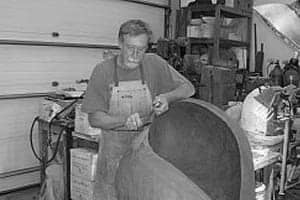
Artist Michael Warrick believes in the healing power of nature.
So when he was approached about creating a sculpture for the atrium of the Winthrop P. Rockefeller Cancer Institute, he took his cue from the building’s natural elements.
“The environment was open and celebrated nature through the use of natural materials, natural light and plants,” he said. “It was not an oppressive building at all, but all felt very positive.”

Warrick, an art professor at the University of Arkansas at Little Rock, said that he has long been inspired by seeds and vessels, and he embraced the opportunity to embody these two elements for the Cancer Institute.
“The basic concept I was given was of a vessel that patients could drop tokens into, symbolizing their healing,” he said. Warrick developed drawings, scale models and four studies, of which members of the Cancer Institute’s leadership selected the one that now resides in the atrium.
Warrick also designed the shape of the tokens, which the patients are given upon the completion of their active treatment. Nurses, volunteers and staff members gather for each Seed of Hope ceremony, at which a patient symbolically drops a token into the sculpture. They also are given one token to keep or pass along to someone else facing a struggle.
“We don’t have a lot of rituals in our lives,” Warrick said. “Having a sense of completion, especially with something like cancer treatment, is really positive.”
Janie Lowe, director of the Cancer Institute Department of Volunteer Services, agrees. “Our volunteers have gotten to be part of several Seed of Hope ceremonies in just the first few weeks since our building expansion opened. We’ve shared both tears and laughter with our patients. They are so honored to have the opportunity to place their token next the tokens of so many other survivors.” The Cancer Institute Auxiliary also financially supports the Seed of Hope as part of its focus on patient-centered programs.
The Seed of Hope, which was carved in five weeks from a 3,700 lb. piece of Turkish white pearl marble, immediately became a symbol for the Cancer Institute and a significant part of its environment. When designing the sculpture, Warrick made a concerted effort to create not just a sculpture, but a comprehensive concept that he said felt “fluid, complete and positive.”
“I really consider it a masterpiece,” he said, adding that one of his students volunteered about 50 hours to help him complete the piece. “It’s strong, it’s simple and it makes sense as part of the Cancer Institute’s overall environment. It’s really taken on a life of its own, which is exactly what we wanted.”
Michael Warrick Biography
Michael Warrick is a professor of sculpture at the University of Arkansas at Little Rock. His distinguished national exhibition record spans more than three decades with 40 solo exhibits and 147 competitive and invitational exhibits.
He is the recipient of numerous regional and national grants and fellowships such as a National Endowment for the Arts Fellowship through the Ragdale Foundation in Lake Forest, Ill.; a Visual Arts Grant from the Southeastern College Art Conference in Chapel Hill, N.C.; an Arkansas Arts Council Visual Arts Fellowship; and artist grants from Art Matters, Inc., and the Pollack-Krazner Foundation, both located in New York City.
During 2009, he was given the Award for Outstanding Artistic Achievement by the Southeastern College Art Conference in Chapel Hill, N.C. He has also been a visiting artist, artist-in-residence, lecturer or panelist at 92 institutions and has installed outdoor sculptural works in Arkansas, Alabama, Tennessee, Kansas, Louisiana, Missouri, Illinois, North Carolina, South Carolina, Maine, Nebraska, Texas, Kentucky, South Dakota and New York.
In 2001 and 2002, he completed sculpture commissions for the University of Arkansas and the National Park Service’s Central High Museum in Little Rock. In 2008, he created two monumental sculptures in granite and bronze for international sculpture parks in Changchun, China, and in 2009 and 2010 he was commissioned to develop works for the Central Arkansas Library, the Bernice Garden and the UAMS Winthrop P. Rockefeller Cancer Institute in Little Rock.
